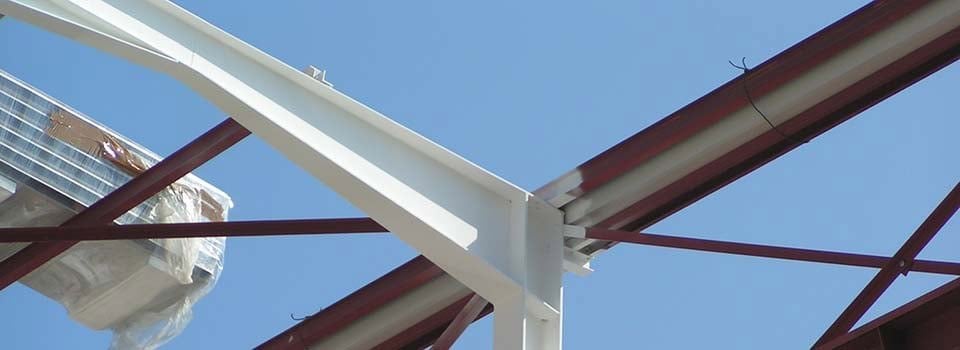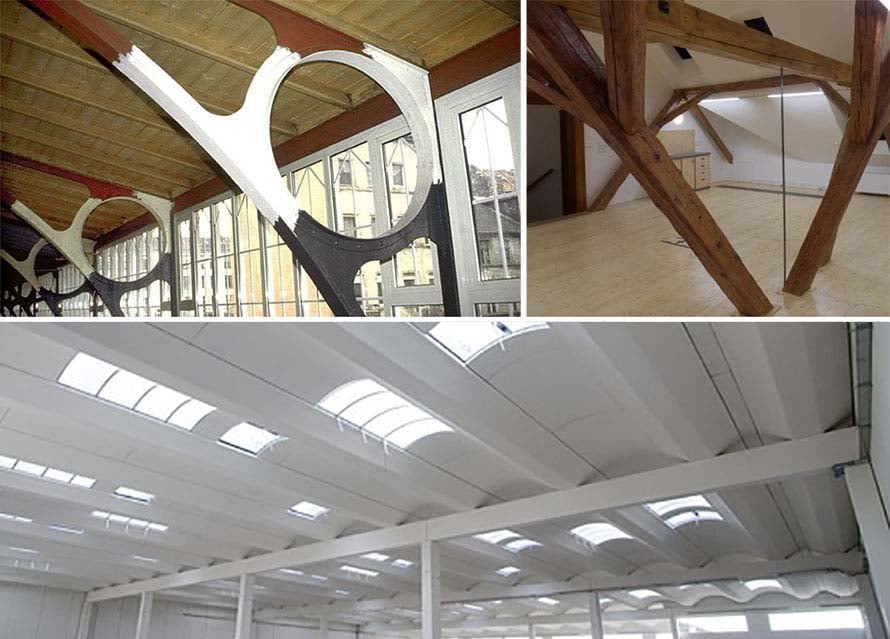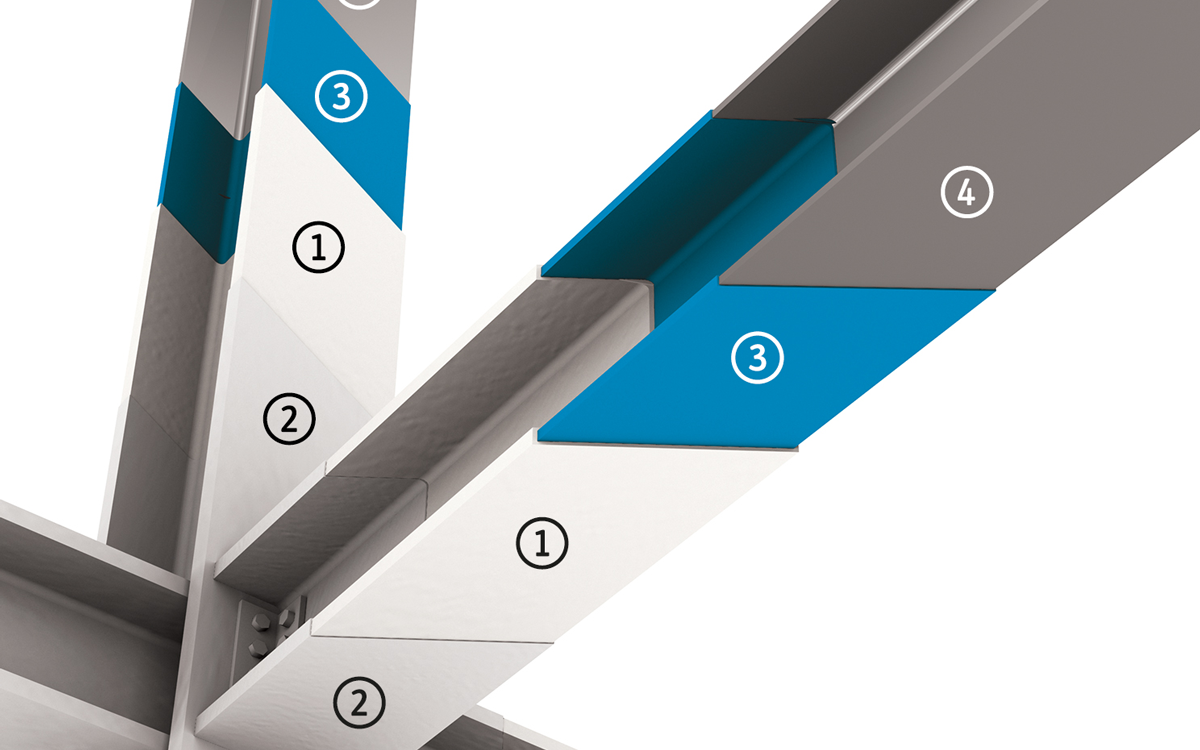
Intumescent coating, often referred to as intumescent paint, is one of the easiest and most efficient ways to protect load bearing elements of buildings against fire. Intumescent coating delays the collapse of the structure through insulating the structural elements (columns and beams) that support the building, thus helping achieve fire resistance levels specified in terms of time. Therefore it fulfills the highest priority of passive fire protection, preventing the collapse of the building, allowing the time for safe evacuation of people from it, and making it safer for the emergency services and rescue team.
Intumescent coating are an increasingly used way of providing passive fire protection to the load-bearing structures, especially structural steel, which is becoming more and more popular in modern architectural design of both industrial and commercial buildings. As a means of fire protection, it presents several advantages:
- it does not modify the intrinsic properties of materials;and
- it is easily applied

How intumescent paints work?
To intumesce, means that a product swells as a result of heat exposure, thus increasing in volume and decreasing in density. An intumescent paint is a coating that reacts to heat by swelling in a controlled manner to many times its original thickness, producing a carbonaceous char formed by a large number of small bubbles that act as an insulating layer to protect the substrate.
The purpose of intumescent products is the prevention of the structural collapse of the building, which can occur if load bearing steel elements reach a critical state.
For steel, this is linked to the critical or limiting temperature, defined as the temperature at which the load bearing capacity becomes equal to the effect of the applied loads (so the steel element is very close to the collapse). Critical temperature of steel can vary from 350 °C to 750 °C, depending mainly on the loading scheme, but in most of the cases between 500 °C and 620 °C.
How to correctly apply intumescent paints to steel materials - preparation tips
Intumescent paints are always part of a system. For steelworks, the system include an anticorrosive primer and a topcoat where required. For the primer, the important criteria are assuring adhesion to substrate in cold state, anticorrosion protection and stickability of intumescent char formed during fire exposure. For the topcoat the criteria are aesthetic function and, as a sealer to prevent early degradation and inactivation of intumescent layer when used externally and areas with a high moisture atmosphere.
Before being coated with a compatible primer, steelwork must be prepared according to SA 2.5. If that is already the case, it must be cleaned and free from grease, oil, rust, dirt or any other contaminant that may inhibit the bonding.
Compatible primers, tested with Promat products are:
- Acrylic
- Alkyd Zinc Phosphate
- Two component epoxy
- Zinc rich epoxy
- Zinc silicate
Although a tie coat will be required for Zinc Rich and Zinc Silicate

For speed and quality of finish, intumescent coatings are preferably spray applied with airless paint equipment. Brush and roller application may also be possible.
- Spray, brush or roller applied intumescent paint.
- Spray, brush or roller applied topcoat (if necessary).
- Primer approved by international certification or by Promat. Please contact our technical department.
- Structural steel column and beam. Clean, dry and free from dust, oil, loose mill scale or rust and any other condition preventing good adhesion AND blast cleaned in accordance proper international standards.
What is dry film thickness (DFT) of intumescent paints?
The dry film thickness and quantity of material required for a certain fire resistance time (30, 60, 90, 120 minutes) depends upon various factors.
Dry film thickness of intumescent products for structural steel is determined by the following factors:
- Mass factor (called also massivity, section factor or Hp /A or Ap /V), a ratio between the area of the steel exposed to the fire and the volume of the steel section. The higher the mass factor, the faster the steel section heats up, and the greater the thickness of fire protection material required.
- Exposure or number of faces exposed to fire. Is it a column or a beam, a composite element, a hollow section…?
- Critical temperature is the limiting temperature as a function of the degree of utilization. The lower the critical temperature, the faster the steel section will reach it, and the greater the thickness of fire protection material required.
- Duration or fire rating or the level of protection required (60, 90, 120 mins etc.).
- Test Standards and Approvals - different calculation methods can give different thickness for the same protection.
When to measure wet film thickness (WFT) and dry film thickness (DFT)?
During the application, it is necessary to frequently measure the wet film thickness (WFT) with a wet film thickness gauge.
To determine dry film thickness (DFT) based on the wet film thickness (WTF), it is necessary to multiply the WFT with a specific number that is different from product to product. For Promat’s product range, the value is 0.7
The maximum thickness that can be applied for each coating varies by product as well as related consumption (TSR: theoretical spread rate).
Following the sufficient period of drying, a survey of dry film thickness should be carried out using a suitable calibrated gauge. An electromagnetic induction instrument with a statistical function to store readings and calculate their averages is most useful. Where dry film readings include a primer and/or topcoat, allowance must be made for these coatings and subtracted from the total reading.
Do I need to apply top coating on intumescent paint for steel protection?
Intumescent paint for normal interior application can be used without any additional decorative top layer. Adding a topcoat is necessary for external or high ambient humidity applications.
The nature of the environment to which the coatings will be exposed may affect their durability or their performance in a fire situation. If necessary, a topcoat must be applied to the surface of the intumescent coating, either as a protection against environment degradation or for decorative purposes.
The main chemical families of topcoat used for environmental protection are:
- two component polyurethane top coat
- two component acrylic polyurethane
- copolymer acrylic
- polyurethane
- acrylic PU
- epoxy



